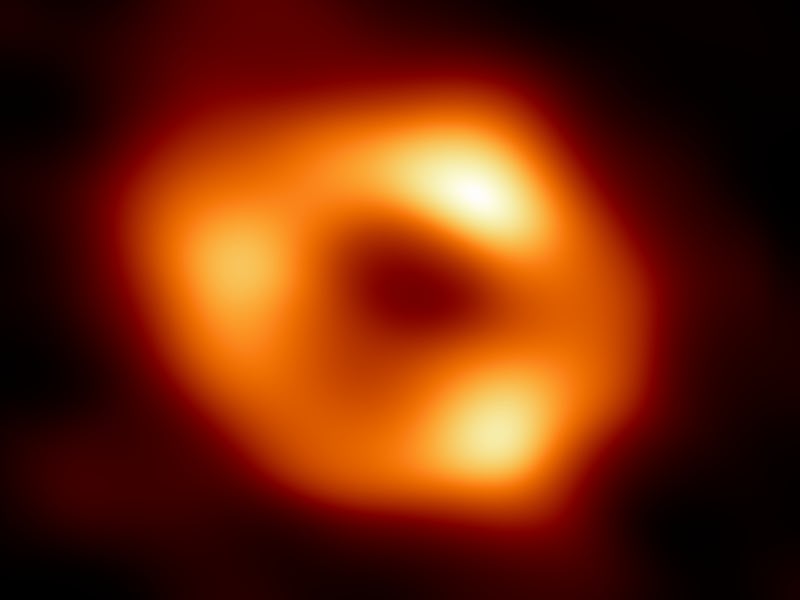New picture answers many questions about our galaxy's black hole — and reveals some mysteries
The recently-released image shows how Sagittarius A* is both mundane and very strange, all at once.

After more than five years of data modeling, analysis, and even hauling hard drives around the world, astronomers have finally released the first-ever snapshot of the black hole at the center of our galaxy.
Astronomers have long suspected that an invisible diner some 27,000 light-years from Earth was gobbling up starlight, but the new image is the first tangible confirmation of this hunch. Named Sagittarius A*, or Sgr A* for short, this supermassive black hole appears donut-shaped in its portrait with several light spots along its back.
Lindy Blackburn is a radio astronomer at the Center for Astrophysics | Harvard & Smithsonian and one of the scientists responsible for analyzing the data collected by the Event Horizon Telescope (EHT) collaboration, which captured and assembled the latest image. Beyond the wonder of the image itself, Blackburn says that this finding will also play a significant role in advancing the scientific understanding of black holes.
“Now that we know it is possible to image the black hole at the center of our galaxy, we are working toward a next-generation EHT,” Blackburn says.
Prior to the EHT picture, the central image from NASA’s Chandra X-ray telescope was one of the best glimpses of the mysterious black hole at the center of our galaxy.
What scientists got right — Black holes in science fiction are often depicted as swirling voids or black chasms prepared to sweep spacecraft over their event horizon to a point of no return, not unlike explorers of ancient myths falling off the edge of a flat Earth.
However, recent groundbreaking work by the EHT has revealed that this depiction may be a bit of a stretch. Thanks to the first image of the M87 black hole released by the collaboration in 2019, astronomers believed that black holes appeared to be more donut-shaped in reality, with blackness at the center and outside. Because the black holes themselves are still invisible to us and our telescopes, the donut shape actually highlights the heat coming off the matter as it whizzes around the black hole.
Seeing that Sgr A* had the same donut shape as M87 confirmed for astronomers that supermassive black holes of very different sizes — M87 is over 1,000 times more massive — had the same general structure. Blackburn says that the appearance of Sgr A* also confirmed some long-standing scientific theories.
“One of the most striking features of the Sgr A* image is that the size of its lensed ring of emission perfectly matches that predicted by General Relativity,” he says.
Blackburn also says that the light patches on Sgr A* weren’t much of a surprise either and could reflect the dynamic plasma surrounding the black hole.
“We would expect such features to vary throughout the course of a night,” he says. “Future observations should reveal if this is indeed the case.”
A few surprises — Not all the findings from Sgr A* were exactly as scientists predicted, however. The first surprise was the ring’s “relatively even distribution of brightness” which suggests that it may be oriented face-on with its axis of rotation pointed toward Earth. The black hole is also “curiously” misaligned with the midplane of the galaxy, Blackburn says.
Another unexpected discovery uncovered through imaging Sgr A* was that the level of variability in some of its measurements were less than predicted by computer simulations.
This means “there is something we don’t quite understand about the plasma behavior in the accretion flow,” Blackburn says.
Accretion disks around black holes are the messy crumbs left behind when gobbling up their meals. Better understanding these disks could help scientists study the behavior of black holes as a whole, a subject that is still riddled with mysteries.
What’s next — With two black holes successfully resolved, Blackburn says that the EHT has some big plans for how to study these objects next.
“We are working toward a next-generation EHT that will actually be able to capture movies of a source at multiple frequencies, revealing the inflow and outflow dynamics near the boundary of a black hole as well as the nature of flares,” he says.
One thing is certain: Black hole science is only going to get more exciting in the years to come.
This article was originally published on